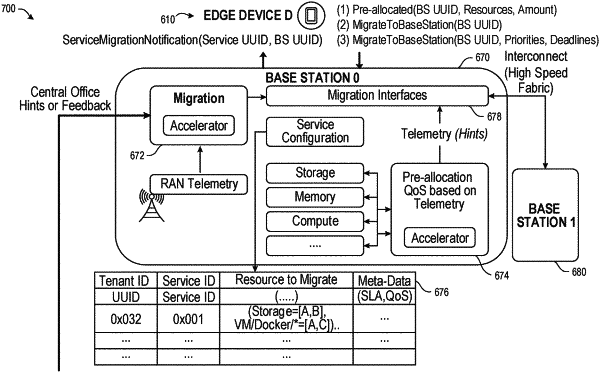| CPC H04L 67/148 (2013.01) [G06F 9/4856 (2013.01); H04L 41/5019 (2013.01); H04L 43/0811 (2013.01); H04L 47/82 (2013.01); H04L 67/10 (2013.01); H04L 67/34 (2013.01); H04W 4/40 (2018.02); H04W 4/70 (2018.02); H04L 41/5003 (2013.01)] | 28 Claims |

|
1. An edge computing apparatus, comprising:
processing circuitry; and
memory, including instructions stored thereon that, when executed by the processing circuitry, cause the processing circuitry to perform operations that:
identify a service operated with one or more computing resources of the edge computing apparatus, the service providing computing capabilities for an edge device to be connected to the edge computing apparatus with one or more Quality of Service (QoS) requirements, wherein the one or more QoS requirements includes a security requirement, wherein the security requirement includes pre-registration of the service;
identify a mobility condition for the service, based on a change in network connectivity from the edge computing apparatus to the edge device;
identify a second edge computing apparatus;
determine whether the second edge computing apparatus supports the security requirement, the determination including:
receiving a security configuration from the second edge computing apparatus; and
validating, based on the received security configuration, that the second edge computing apparatus provides equivalent security capabilities to the edge computing apparatus by comparing the received security configuration with a security configuration of the edge computing apparatus;
proactively reserve based on one or more predictive analytics used to determine resource needs based on anticipated service demands and network conditions, a resource for the service, prior to migration of the service, to be launched at the second edge computing apparatus;
implementing a deadline-driven allocation of the proactively reserved resource by determining one or more time points for the resource needs;
adjusting allocation of the proactively reserved resource to meet the deadline-driven allocation based at least in part on updated predictive analytics; and
responsive to a determination that the second edge computing apparatus supports the security requirement, cause a migration of the service to the second edge computing apparatus.
|